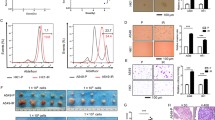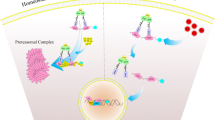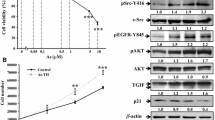Abstract
Arsenic compounds are a somewhat unique class of metals, which have been considered as both carcinogens and chemotherapeutic agents for cancers. Tumor promotion effects of arsenic are believed to be associated with its transactivational activities on transcription factors, such as AP‐1 and NFκB, while the induction of cell apoptosis and differentiation by arsenic is considered to be a mechanism for the chemotherapeutic effects of arsenic. Here, we found that exposure of cells to arsenite and arsenate leads to transactivation of retinoic acid response elements (RARE) and glucocorticoid response elements (GRE) in mouse epidermal JB6 cells. These inductions occur in a time‐dependent manner. Furthermore, induction of RARE activity by arsenic was synergistically enhanced by co‐treatment of cells with retinoic acid, while GRE activation by arsenic was not affected by combined treatment of cells with fluocinolone acetonide (FA). In consideration of the important role of RARE and GRE in induction of cell differentiation, we speculate that transactivation of RARE and GRE by arsenic may be involved in its induction of cell differentiation and anti-cancer activities in addition to its induction of apoptosis.
Similar content being viewed by others
References
Chen C-J, Wang C-J: Ecological correlation between arsenic levels in well water and age-adjusted mortality from malignant neoplasms. Cancer Res 50: 5470–5474, 1990
Gilman JPW, Swierenga SHH: Inorganic carcinogenesis. In: C.E. Searle (ed). Chemical Carcinogenesis, 2nd edn. American Cancer Society Monograph, Washington, DC, 1985, 577–630
Smith AH, Hopenhayn-Rich C, Bates MN, Goeden HM, Hertz-Picciotto P, Duggan HM, Wood R, Kornett MJ, Smith MT: Cancer risks from arsenic in drinking water. Environ Health Perspect 97: 259–267, 1992
Snow ET: Metal carcinogenesis: Mechanistic implications. Pharmacol Ther 53: 31–65, 1992
Huang C, Ma W-Y, Li J, Goranson A, Dong Z: Requirement of Erks, but not JNKs, for arsenite-induced cell transformation. J Biol Chem 274: 14595–14601, 1999
Chan PC, Huff J: Arsenic carcinogenesis in animals and in humans: Mechanistic, experimental, and epidemiological evidence. Environ Carcinogen Ecotox Rev C15: 83–122, 1997
International Agency for Research on Cancer: IARC Monograph on Evaluation of Carcinogenic Risk to Humans 23: 39–324, 1980
International Agency for Research on Cancer: IARC Monograph on Evaluation of Carcinogenic Risks to Humans 7(suppl): 100–134, 1987
National Institute for Occupational Safety and Health: National Occupational Exposure Survey (1980-1983). Department of Health and Human Services, Cincinnati, OH, 1984
Lansdown ABG: Physiological and toxicological changes in the skin resulting from the action and interaction of metal ions. Crit Rev Toxicol 25: 397–462, 1995
Luchtrath H: The consequences of chronic arsenic poisoning among Moselle wine growers. Pathoanatomical investigations of post-mortem examinations performed between 1960 and 1977. J Cancer Res Clin Oncol 105: 173–182, 1983
Philipp R: Arsenic exposure: Health effects and the risk of cancer. Rev Environ Health 5: 27–57, 1985
Bainbridge WS: In: The Cancer Problem. Macmillan, New York, 1914, p 271
Forkner C, McNair-Scott TF: Arsenic as a therapeutic agent in chronic myeloid leukemia. J Am Med Assoc 97: 305, 1931
Kandel EV, Leroy GV: Chronic arsenic poisoning during the treatment of chronic myeloid leukemia. Arch Intern Med 60: 846–866, 1937
Konig A, Wrazel L, Warrell RP Jr, Rivi R, Pandolfi PP, Jakubowski A, Gabrilove JL: Comparative activity of melarsoprol and arsenic trioxide in chronic B-cell leukemia lines. Blood 90: 562–570, 1997
Chen GQ, Shi XG, Tang W, Xiong SM, Zhu J, Cai X, Han ZG, Ni JH, Shi GY, Jia PM, Liu MM, He KL, Niu C, Ma J, Zhang P, Zhang TD, Paul P, Naoe T, Kitamura K, Miller W, Waxman S, Wang ZY, de The H, Chen SJ, Chen Z: Use of arsenic trioxide (As2O3) in the treatment of acute promyelocytic leukemia (APL): I. As2O3 exerts dose-dependent dual effects on APL cells. Blood 89: 3345–3353, 1997
Chen GQ, Zhu J, Shi XG, Ni JH, Zhong HJ, Si GY, Jin XL, Tang W, Li XS, Xong SM, Shen ZX, Sun GL, Ma J, Zhang P, Zhang TD, Gazin C, Naoe T, Chen SJ, Wang ZY, Chen Z: In vitro studies on cellular and molecular mechanisms of arsenic trioxide (As2O3) in the treatment of acute promyelocytic leukemia: As2O3 induces NB4 cell apoptosis with downregulation of Bcl-2 expression and modulation of PML-RAR alpha/PML proteins. Blood 88: 1052–1061, 1996
Jiang Su New Medical College: In: Encyclopedia of Chinese Medicine. Shanghai Scientific Publishing House, Shanghai, China, 1986, pp 1620–1622
Snow ET: Metal carcinogenesis: Mechanistic implications. Pharma Ther 53: 31–65, 1992
Chen NY, Ma WY, Huang C, Ding M, Dong D. Activation of PKC is required for arsenite-induced signal transduction. J Environ Pathol Toxicol Oncol 19: 297–305, 2000
Cavigelli M, Li WW, Lin A, Su B, Yoshioka K, Karin M: The tumor promoter arsenite stimulates AP-1 activity by inhibiting a JNK phosphatase. EMBO J 15: 6269–6279, 1996
Ludwig S, Hoffmeyer A, Goebeler M, Kilian K, Häfner H, Neufeld B, Han J, Rapp UR: The stress inducer arsenite activates mitogen-activated protein kinases extracellular signal-regulated kinases 1 and 2 via a MAPK kinase 6/p38-dependent pathway. J Biol Chem 273: 1917–1922, 1998
Simeonova PP, Luster MI: Mechanisms of arsenic carcinogenicity: Genetic or epigenetic mechanisms? J Environ Pathol Toxicol Oncol 19: 281–286, 2000
Simeonova PP, Wang S, Toriuma W, Kommineni V, Matheson J, Unimye N, Kayama F, Harki D, Ding M, Vallyathan V, Luster MI: Arsenic mediates cell proliferation and gene expression in the bladder epithelium: Association with activating protein-1 transactivation. Cancer Res 60: 3445–3453, 2000
Huang C, Li J, Ma W-Y, Chen N-Y, Dong Z: Activation of AP-1 by arsenate and arsenate in both cell and AP-1 luciferase-transgenic mice. FASEB J (in press)
Huang C, Ma WY, Li J, Dong Z: Arsenic induces apoptosis through a c-Jun NH2-terminal kinase-dependent, p53-independent pathway. Cancer Res 59: 3053–3058, 1999
Li YM, Broome JD: Arsenic targets tubulins to induce apoptosis in myeloid leukemia cells. Cancer Res 59: 776–780, 1999
Rousselot P, Labaume S, Marolleau JP, Larghero J, Noguera MH, Brouet JC, Fermand JP: Arsenic trioxide and melarsoprol induce apoptosis in plasma cell lines and in plasma cells from myeloma patients. Cancer Res 59: 1041–1048, 1999
Zhu XH, Shen YL, Jing YK, Cai X, Jia PM, Huang Y, Tang W, Shi GY, Sun YP, Dai J, Wang ZY, Chen SJ, Zhang TD, Waxman S, Chen Z, Chen GQ: Apoptosis and growth inhibition in malignant lymphocytes after treatment with arsenic trioxide at clinically achievable concentrations. J Natl Cancer Inst 91: 772–778, 1999
Huang C, Ma W-Y, Bowden GT, Dong Z: Ultraviolet B-induced activated protein-1 activation does not require epidermal growth factor receptor but is blocked by a dominant negative PKCλ/ι. J Biol Chem 49: 31262–31268, 1996
Huang C, Ma W-Y, Young MR, Colburn N, Dong Z: Shortage of mitogen-activated protein kinase is responsible for resistance to AP-1 transactivation and transformation in mouse JB6 cells. Proc Natl Acad Sci USA 95: 156–161, 1998
Gianni M, Koken MH, Chelbi-Alix MK, Benoit G, Lanotte M, Chen Z, de The H: Combined arsenic and retinoic acid treatment enhances differentiation and apoptosis in arsenic-resistant NB4 cells. Blood 91: 4300–4310, 1998
Chambon P: A decade of molecular biology of retinoic acid receptors. FASEB J 10: 940–954, 1996
Glass CK, Rosenfeld MG, Rose DW, Kurokawa R, Kamei Y, Xu L, Torchia J, Ogliastro MH, Westin S: Mechanisms of transcriptional activation by retinoic acid receptors. Biochem Soc Trans 25: 602–605, 1997
Lehmann JM, Jong L, Fanjul A, Cameron JF, Lu XP, Haefner P, Dawson MI, Pfahl M: Retinoids selective for retinoid X receptor response pathways. Science 258: 1944–1946, 1992
Simons SS Jr, Chakraborti PK, Cavanaugh AH: Arsenite and cadmium (II) as probes of glucocorticoid receptor structure and function. J Biol Chem 265: 1938–1945, 1990
Sanchez ER: Heat shock induces translocation to the nucleus of the unliganded glucocorticoid receptor. J Biol Chem 267: 17–20, 1992
Hamilton JW, Kaltreider RC, Davis AM, Green RA: Arsenite (II) and chromium (VI) alter glucocorticoid receptor (GR) function and GR-dependent gene regulation. Metal Ions Biol Med 6: 66–68, 2000
Huang C, Ma W-Y, Dawson MI, Rincon M, Flavell RA, Dong Z: Blocking activator protein-1 activity, but not activating retinoic acid response element, is required for the antitumor promotion effect of retinoic acid. Proc Natl Acad Sci USA 94: 5826–5830, 1997
Li JJ, Dong Z, Dawson MI, Colburn NH: Inhibition of tumor promoter-induced transformation by retinoids that transrepress AP-1 without transactivating retinoic acid response element. Cancer Res 56: 483–489, 1996
Minucci S, Leid M, Toyama R, Saint-Jeannet JP, Peterson VJ, Horn V, Ishmael JE, Bhattacharyya N, Dey A, Dawid IB, Ozato K: Retinoid X receptor (RXR) within the RXR-retinoic acid receptor heterodimer binds its ligand and enhances retinoid-dependent gene expression. Mol Cell Biol 17: 644–655, 1997
Budunova IV, Carbajal S, Kang H-I, Viaje A, Slaga TJ: Altered glucocorticoid receptor expression and function during mouse skin carcinogenesis. Mol Carcinogen 18: 177–185, 1997
Adcock IM: Molecular mechanisms of glucocorticosteroid actions. Pulm Pharmacol Ther 13: 115–126, 2000
Weigel NL: Steroid hormone receptors and their regulation by phosphorylation. Biochem J 319: 657–667, 1996
Author information
Authors and Affiliations
Corresponding author
Rights and permissions
About this article
Cite this article
Huang, C., Li, J., Ding, M. et al. Transactivation of RARE and GRE in the cellular response to arsenic. Mol Cell Biochem 222, 119–125 (2001). https://doi.org/10.1023/A:1017975610084
Issue Date:
DOI: https://doi.org/10.1023/A:1017975610084




